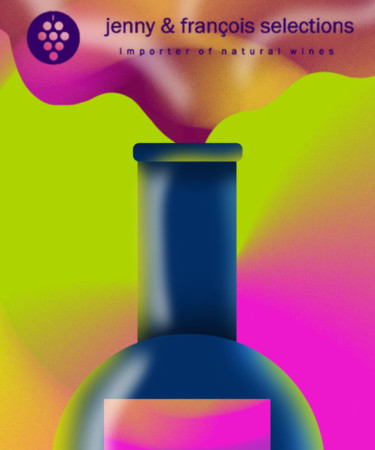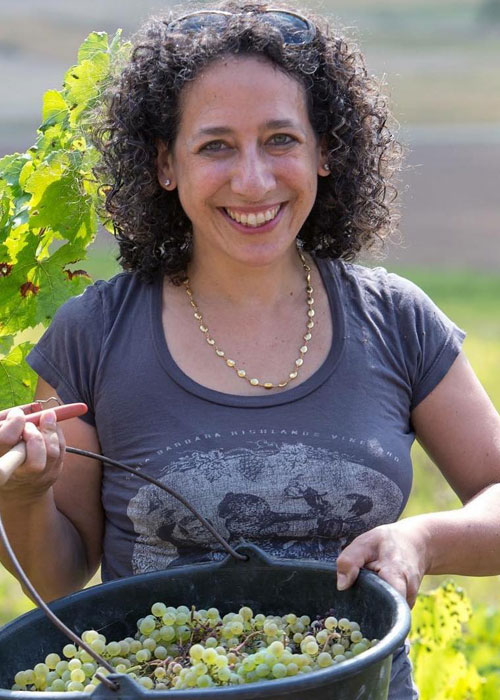Turning over a bottle to find the importer can be a great way to explore new varietals and producers, or make a quick call on what to bring home when you’re riddled with indecision at the bottle shop. In this interview series, we’ll be chatting with importers across the country who have different philosophies, markets, and preferences when it comes to the kinds of wines they welcome into their portfolios. We hope that getting to know them leads you to a few new favorites!
When Jenny & Francois Selections began importing wines in 2000, natural wine was far less known than it is today. Founder Jenny Lefcourt discovered her passion for the category while traveling to Paris and pursuing a Ph.D. in French literature and film at Harvard, and was captivated by how approachable, thoughtfully produced, and, most importantly, delicious these wines could be. Fast forward to 2022, and J&F is known across the industry, and natural wine is a term that continues to inspire debate, new bars and bottle shops, and drinker discovery.
We spoke with Lefcourt about what J&F has been doing for the past two decades, how that mission has evolved, and what to expect out of your next bottle that bears the brand’s signature grape cluster logo on one side. Plus, she shares five of her favorite wines from the J&F portfolio to try right now.
This conversation has been edited and condensed for clarity.
What is your importing philosophy?
We’ve done one thing and one thing only since our inception in 2000: import natural, biodynamic, and organic wines. We were one of the first to focus on natural wines before it even had a name. Back then, there was no name for natural wine, and it was astonishing to encounter the wines and the winemakers to find that common thread.
What kinds of wines and winemakers excite you, and why?
These days, I taste a million wines all of the time, but it’s not easy to find a great wine. It takes a lot of exploring. When I do happen upon a wine that is interesting, natural, and layered, it’s incredibly exciting — it’s a feeling of connection. When you encounter it, it’s clear that it’s a wine with a strong backbone made by someone with a strong belief system.
How does a winery end up in the J&F portfolio?
Once I taste and decide that I like a wine, I visit the winery and meet the grower. I’ve found that the grower always resembles their wine in a way. Natural winemakers have a really strong belief system, and that comes through in the bottle. They respect the earth, they respect their team, and so it shines through in their wines. Winemakers will also reach out to us.
Including wines that are affordable is important to me — I want to carry everyday drinking wines that are available and pleasurable. As I’ve become more experienced, I’ve also gone to organic and biodynamic vineyards to say things like, “Hey, if you’re comfortable going one step further and using indigenous yeast, not filtering, lowering the level of sulfates, and using a label I create, let’s talk.” An example of a collaboration like this is Where’s Linus?, a natural wine label that J&F launched with Chris Christensen of Bodkin Wine.
Who is your target drinker, and how has that target evolved since 2000?
People who care about the pleasure of drinking something interesting, but also care where it comes from and how it’s made and the philosophy behind it. People who care about the story of the person making it. It’s a whole package of integrity.
What’s been the biggest surprise for you as an importer?
I’ve been pleasantly surprised by the openness drinkers have shown towards the newer countries in wine that we’ve brought in, like wines from the Czech Republic. For years, their land was confiscated, and people got some land back and now they’re making stunning wines. For example, Milan Nestarec’s Forks and Knives red, white, and rosé wines — I can’t believe how well they’ve done across the country, but they’re just delicious, everyday wines. Same goes for the wines of Austria; there’s absolutely amazing options to be found there.
For someone who’s trying to understand the role an importer plays in the wine businesses, how would you best explain what you do?
We’re in the business of curating! Just as someone would curate a museum exhibit, I curate a portfolio of wines that I believe in. I select them, ship them to the U.S., and distribute them across the country.
5 Wines to Try From Jenny & Francois Selections
Domaine des 2 Anes, Fontanilles, Corbieres
Carignan is an underrated grape. Magali Terrier treats her 80-year-old vines with respect and they repay her with a smooth berry-filled wine with the thyme, rosemary, and lavender aromas that fill the air when you walk through the garrigues surrounding these old gnarly vines. Her lovely donkeys nibble on the shrubs, keeping any fires at bay and putting a smile on Terrier’s face when she takes a break to hug Riquita, Pinoccio and their mom Lolita — yes, three donkeys!
Christian Tschida’s Birdscapes
Birdscape, with an incredibly intricate label by Erro, an Icelandic pop artist, shows all the complexity and contradiction of Tschida, who is, in my opinion, one of the truly best natural winemakers out there. He lightly extracts a small amount of contact with the skins, which results in wine that is difficult to define. For the red — is it a red? And the white — is it an orange wine? They are elegant and multilayered, like the person behind them, as well as the labels on the bottle. Christian’s bottles shine with the care he gives his vines. He even called the top bee scientist in Europe to see if he could do anything to make his vines more hospitable to bees, and was told he is already doing everything to create the biodiversity necessary to make them feel at home.
From the Tank
Economical, ecological, and delicious, I created From the Tank with the idea of putting high-quality wine in a box. It’s lighter to transport, and there’s less waste — it is vacuum sealed to keep the wine good for weeks. From the Tank channels the local French custom of filling a jug with new wine at the winery, and bringing it home to your glass.
Milan Nestarec’s Forks and Knives Red
Visiting the Czech Republic and meeting Milan Nestarec was a revelation. This is a lesser-known country for wine, and Milan is a young winemaker free to experiment and create truly delicious, gulpable wines. Nestarec’s family started planting on a tiny plot of land that was returned to them as restitution in the 1990s. That was the beginning of what is now 27 hectares. The forks and knives of the label tell us this is an everyday wine to drink with a meal. It is a blend of Pinot Noir, Blaufränkisch, Cabernet Sauvignon, and Cabernet Franc. There’s no sulfur, no fining, no filtration. The purity of this juicy, spicy ferment shines through. Try any of his pretty orange wines as well!
Domaine Plageoles, Mauzac Nature
The Plageoles family is responsible for revitalizing this lesser-known area of Gaillac in southwest France. Bernard Plageoles replanted lost varietals from clippings at the museum of viticulture, and created wines from these long-lost grapes. His son Robert followed, and now his grandson Florent is at the helm. They’re all lovely, gentle folks like the gentle region with gentle hills. The wines are pretty with fine bubbles and offer citrus and apple refreshment.
This story is a part of VP Pro, our free platform and newsletter for drinks industry professionals, covering wine, beer, liquor, and beyond. Sign up for VP Pro now!

